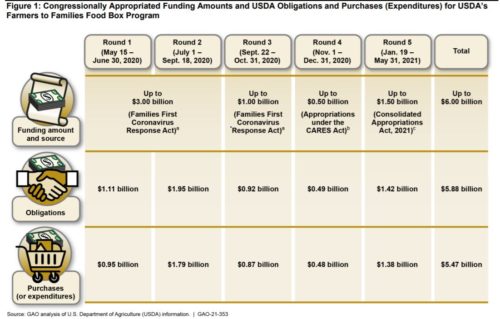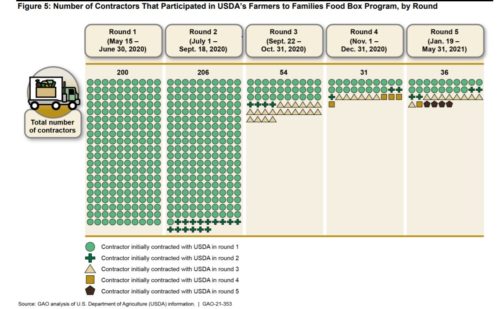USDA’s Harvest Boxes: A GAO analysis
Remember USDA’s Harvest boxes?
I posted about them at least nine times since 2018. For example:
- The Trump Admnistration’s announcement of its forthcoming Blue Apron program. This was widely derided, but USDA’s Sonny Perdue never gave up on it.
- What the Harvest Box program was supposed to do (help farmers, feed the poor)
- What the boxes actually looked like
- And the program’s end
I thought the program was ill conceived from the start. Its idea was to collect food from farmers that could not otherwise be sold, and deliver it to private food banks for distribuiton. There were three types of boxes: produce, dairy products, and meat products.
I worried, and for good reason, about:
- The enormous expense
- The complicated and burdensome logistics
- The burden on food banks
- Most of he money going to distributors rather than small farmers
- The lack of choice for recipients
- The unsustainable focus on charity
Now, the Government Accountability Office (GAO) has issued a report on the program, “USDA Food Box Program: Key Information and Opportunities to Better Assess Performance,”
The program, it says,
- Used 243 contractors
- Delivered more than 176 million boxes of food
- Reached 78% of US counties, and 89% of counties with more than 20% of the population in poverty
By those standards, I guess, it was a success.
Did it help farmers? USDA did not collect data on this point so we don’t know, but I don’t think it did.
The report does provide data on several points.
The astronomical overall expense

The absurdly high cost of each of the boxes

The switch from lots of small farmers to a few big ones

From photographs of the contents of the boxes, it’s hard to believe they would cost more than $10 to $20 at a supermarket. Since so few small farmers were helped by the program, it would have been much cheaper and more efficient to give people coupons for the food or increase SNAP benefits.
But the real purpose of the program was to undermine SNAP. Fortunately, it did not succeed in that purpose.

